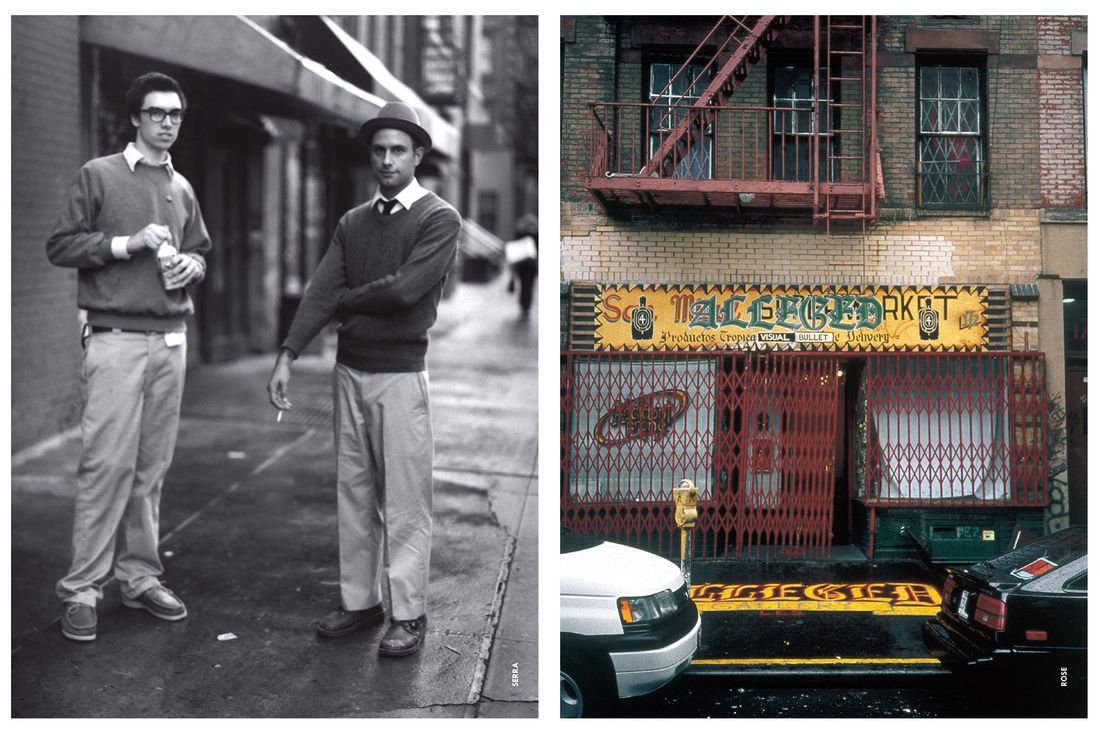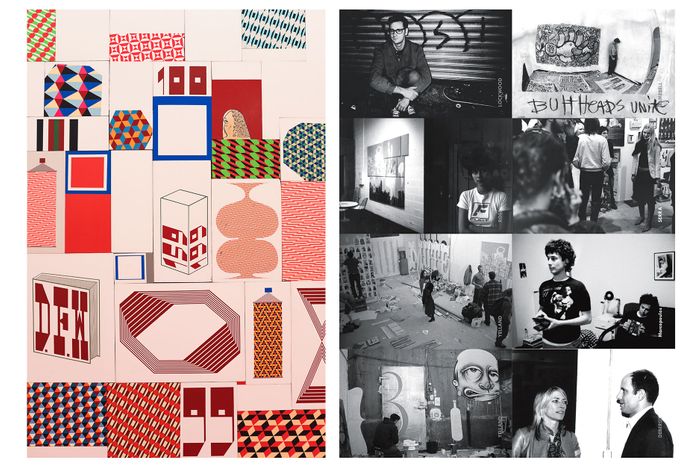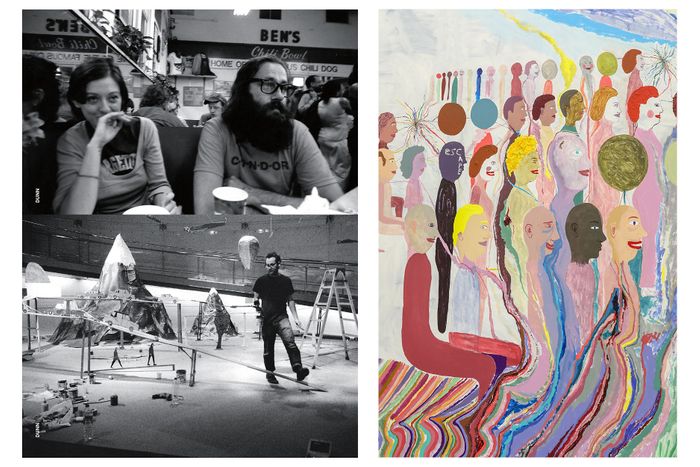
Before Supreme and Stadium Goods brought skate culture to the mainstream, before streetwear hit the runway and sneakers became the new stilettos, there was Alleged. In 1991, Aaron Rose bought a cheap Lower East storefront, unaware that it would become the destination for a budding art collective where he, his skater friends, and really anyone could hang out, create, and exhibit their work at little cost.
The space, rundown and infested with rats, became the party spot of choice for the likes of Chloë Sevigny and Courtney Love, who attended gallery openings featuring work by Mike Mills, Harmony Korine, Margaret Kilgallen, and the rest of their crew. Alleged became an outlet for them apart from the iron gates of the art world establishment, promoting community and creativity over market value. “Everyone was like 21,” Rose says. “We’d have this idea and just make it. Art was like $25 and nothing sold.”
To mark the tenth anniversary of his cult 2008 documentary film Beautiful Losers, which immortalizes Alleged’s status as a ’90s haven until its closing in 2001, Rose partnered with RVCA and Red Hook Labs to bring the gallery back to life. “Now & Then: A Decade of Beautiful Losers” opened today and will be on view for one week until September 1 at The Hole on the Bowery, not too far from the gallery’s original location on Ludlow St. The exhibit is complete with Alleged’s original sign, along with old and newer pieces by the gallery’s artists and exclusive merch.
On Thursday night, the exhibit’s opening reception attracted a crowd spanning generations of New Yorkers, all united by contrarian fervor and the will to create (as well as a deep appreciation for skate culture). Below, the Cut spoke to some of the original “Beautiful Losers” to trace the story of Alleged and its mythic legacy.
AARON ROSE, filmmaker, artist, and creator of Alleged and the documentary Beautiful Losers: It was late 1991, and I broke up with my girlfriend. I was living in Brooklyn, and I had to move out real quick. I met a girl on the corner of First Avenue and 3rd St. I had never met her before, and she said, “I have a storefront on Ludlow St., and we’re moving out in a few weeks. Do you want it?” It was $400 a month, 2,000-square-feet. I got two friends to move in with me, never with any idea to do anything with it. The Max Fish bar opened two doors down, which was a sort of art club, so we decided to have a show, and we just kept doing it.
There was a bodega across the street called Esperanza Grocery. They sold these religious candles in there, and we would put them in the window. They all said “Alleged” on them — like, “Alleged Good Luck Candle,” so you can’t get sued if you don’t have good luck. That’s how we got the name.
MIKE MILLS, filmmaker, artist: If you’ve skated for a big part of your life, did the whole wanting to be pro, wanting to have your own company, knowing everything you can about everything skating thing, meeting another obsessive is just instant community, instant fun.
ED TEMPLETON, skateboarder, artist, photographer: I was doing skateboarding at the time, and I heard about Aaron from my friend who skated with me. He found some of my paintings that I was doing secretly. I just mailed Aaron a package of prints, and in 1994, he invited me to come do a show. So [my wife Deanna and I] rented a minivan, threw in a bunch of paintings, and drove across the country, and I literally walked in and did a show. Aaron was just winging it himself. Coming from the suburbs, it was really eye-opening.
DEANNA TEMPLETON, photographer: We’re from Huntington Beach, California, a very suburban beachside town. It was my first time in New York. We arrived on Halloween. It was complete chaos.
CHERYL DUNN, filmmaker and photographer: Back then, everything was just word on the street. I was pitching a fashion story, and I wanted Phil Frost, this graffiti artist, to paint these fencing masks, like they were Sandinistas or something. I asked Aaron, and already it was known that you’d just roll around the Lower East Side, and there were always people in there just making shit.
DEANNA TEMPLETON: We actually stayed in Alleged, literally in the gallery. Aaron offered us his bed. I remember sitting in the little makeshift living room and seeing something drop out of the corner of my eye. I looked over, and a rat had dropped from the ceiling. I was like, “Okay, this is New York.” It’s true — there’s rats everywhere!
STEPHEN POWERS, graffiti artist: I would go past Tompkins Square Park and every trash can would be on fire. Half the houses in the East Village were boarded up. This is the world we inherited. It was a far different place. It was turned over to the kids, to the people who had the willpower to be here. And the kids had a tremendous amount of fun with it.
ED TEMPLETON: The second time we came, in ’98, Mike Mills let us stay at his apartment. He had done some design work for Anna Sui and had tickets to her fashion show. One minute you’re walking the streets, the next minute you’re watching Kate Moss and Naomi Campbell on the runway. It was just a New York moment. All this stuff happening in one night, maybe it’s normal here.
AARON ROSE: It would be like 2 in the morning, and we’d have this idea and just make it. And the next day, there was an opening.
CHRIS JOHANSON, painter: I always painted right up to the openings.
AARON ROSE: It was never serious. Art was like $25 and nothing sold.
CHRIS JOHANSON: Everything was about the joy of making.
STEPHEN POWERS: [When we were hanging out,] it would seem like it would take two days to get from 8 p.m. to 12 midnight, and it seemed like it would take 15 minutes to get from midnight to 4 a.m.
AARON ROSE: One night, after Max Fish closed, Courtney Love came over for kind of an after-party. She fell asleep on our couch with a bagel with cream cheese in her hand, and a cigarette butt put out into it.
CHERYL DUNN: There was this wild Halloween show in ’99. Phil Frost and [skateboarder] Mark Gonzalez just started doing this weird in-sync, high-step crazy dance together. There’s something about skaters and graffiti artists — their eyes are on every minute detail of the street. They’re staring at the ground so they don’t wipe out; graffiti writers are looking at every single thing so they don’t get caught. There’s just this magical sensibility to this type of character.
AARON ROSE: We had this opening about 5–6 years after the gallery opened called the Independents show. It was massive, another level.
CHERYL DUNN: I knew we had something special when thousands of people were coming to Ludlow St. When things come from the ground up, there’s power in that.
MIKE MILLS: I mean, the Beastie Boys sometimes came by?! I mean, can I meet the Beastie Boys? Thoughts like that were definitely going on. But we all waded through a lot of confusion. There’s something very magical about that time, when it’s all not happening the way you want, for a bunch of you, together.
CHERYL DUNN: We all got invited to Tokyo for this Untitled show, and I just grabbed every camera I had. They encouraged us to be as wild as possible, and there was an open tab at the bar at our hotel. We went bowling, throwing balls at the ceiling.
ED TEMPLETON: That [Tokyo] show was total insanity. This Japanese T-shirt company that funded the entire thing, they flew everyone out. Some of the artists conceived secretly of this idea to do a sort of crash up derby. It turned into this performance art piece. We didn’t have much space, though.
DEANNA TEMPLETON: Thank goodness, because you were just coming off a broken neck.
ED TEMPLETON: It was healed by then.
AARON ROSE: Japan was where Margaret [Kilgallen, artist] found out she was sick. She had to leave that trip early. She had breast cancer once and beat it, but then she found out around that time that she was pregnant. Her hormones went haywire, and it started it up again. She carried through with the pregnancy, and about two weeks after giving birth, we got the call.
DEANNA TEMPLETON: I put Margaret on a pedestal, I just thought the world of her. She sent me my first book on Gloria Steinem.
AARON ROSE: She worked pretty much up to the day she died. She was still doing shows, doing her MFA at Stanford. There were all these graffiti writers doing the sides of buildings and they thought they were the shit. Margaret would just blow them away. And in the softest way — she was very chill, and then she would just go explode this massive wall.
Everyone was like 21. That’s the age you figure out who you are. We all figured out who we are together.
ED TEMPLETON: I think we all bring that do-it-yourself feeling to our shows now. Deanna and I still hang our own work. I bring my own tools and hang everything, even in big galleries. We haven’t got cushy.
These interviews have been edited and condensed. Photography and artwork courtesy of Aaron Rose and The Hole, NYC.
“Now & Then: A Decade Of Beautiful Losers” opens August 24 and is on view at The Hole in New York until September 5. Photographers include Thomas Campbell, Benjamin Deberdt, Cheryl Dunn, Michelle Lockwood, Ari Marcopoulos, Aaron Rose, Marcus Schaffer, Ivory Serra, and Tobin Yelland.












